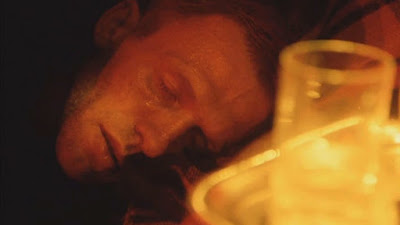Skip to main content
Cult Cinema: A Visitor to a Museum (1989) - Reviewed
 |
| Courtesy of Lenfilm |
Unbeknownst to Western filmgoers, however, is that
Lopushansky wasn’t quite through yet with terrorizing audiences with his dark
apocalyptic visions of people living in Hell.
In fact, the director fashioned something of a quartet quadrilogy of
films starting with Dead Man’s Letters (or Letters from a Dead Man)
and spanning all the way to 2006 with The Ugly Swans. Immediately following in the footsteps of Letters
was the 1989 post-apocalyptic drama film A Visitor to a Museum, a film
which all but picks up right where the prior picture left off. Moreover, this follow-up to the 1986 film
bore the distinction of neorealist casting of non-actors including but not
limited to disabled or mentally handicapped people, adding a patina of
authenticity to the otherwise fantastical proceedings.
Taking place sometime in the future after an unknown global
environmental catastrophe sweeps the planet bathing it in red or orange dust
and decrepitude are two factions of humans, ordinary unaffected people and
disabled “degenerates” mutated by the disaster.
Nearby the sea, a nameless protagonist comes to its precipice waiting
for the overflowing water to dry up and reveal a washed up hidden underground
city whose epicenter consists of an ancient museum. While patiently awaiting the event, the man runs
into ordinary locals dead set against his venturing into the hidden city,
imploring him to stay to hang out, enjoy music or television, eat, drink and
have sex. Meanwhile the so-called “degenerates”
have taken to religion and have found some sort of meaning in their lives while
also mistaking the protagonist for a godlike being as his own journey towards the
hidden city becomes more transformative spiritually and emotionally.
Much like the previous Lenfilm production Letters from a
Dead Man, writer-director Lopushansky’s film wallows in apocalyptic ruin
with vaguely human characters wiggling and thrashing about the scorched
unearthly landscapes. Reuniting the
director with cinematographer Nikolai Pokoptsev, as with Letters the
film has an orangey-brown dimly lit visual schema that will remind some viewers
of Lars Von Trier’s The Element of Crime, also an equally dense
brooder. There’s also a moody ambient score
rendered disturbingly by Vladimir Deshov, Viktor Kisin and Alfred Schnittke
which soaks the viewer through to the bone with unease if not a sense of
dread. Unlike Letters however
which had the contributions of legendary author Boris Strugatsky, Lopushansky
is flying solo this time, pulling from kindred post-apocalyptic terrain but
with a decidedly docudrama approach while keeping the names and narrative
intent nebulous.
Though the film features many actors including but not
limited to Viktor Mikhailov as the titular Visitor, Vera Mayorova and
Vadim Lobanov as the beleaguered hotel managers and Irina Rakshina as a “degenerate”
maid, Lopushanksky and his cameraman are the real stars of this sordid rusting
show. Running considerably longer than Letters
with some sequences that intentionally meander with a kind of sleepiness
akin to the aforementioned Von Trier and particularly David Lynch, A Visitor
to a Museum or Museum Visitor depending on the translation is like
being stuck deep in the Temple of Doom without an exit while the sky
fluctuates between yucky grays and deep oppressive reds. Not to mention the sound design which drifts
between choral voices and distant screams, making it an unpleasant place to
hear.
Less of a straightforward narrative than a sensory
experience that lulls you into a false sense of comfort and security before
gradually inching you closer and closer to the mouth of Hell itself, A Visitor
to a Museum became the second entry in what would ultimately become a
quartet of Russian cinematic Hellscapes with startling vastness and a dedicated
cast ready for anything. How Soviet
audiences must’ve reacted to this waking nightmare is anyone’s guess but as an
American filmgoer it was a slowly roasted burn that gradually siphoned out any
and all tiny rays of hope for a positive outcome. Almost expressionist in its flickering
gold/yellow vistas and sense of the uncanny, Lopushansky’s despairing horror
film isn’t for all tastes but those keen on atmospheric horror that doesn’t
quite reveal its purpose immediately will love swimming deep through its
nuclear contaminated waters.
--Andrew Kotwicki





